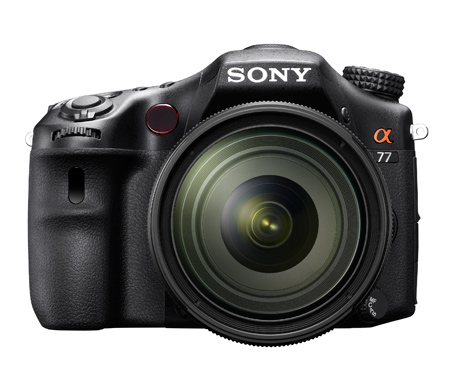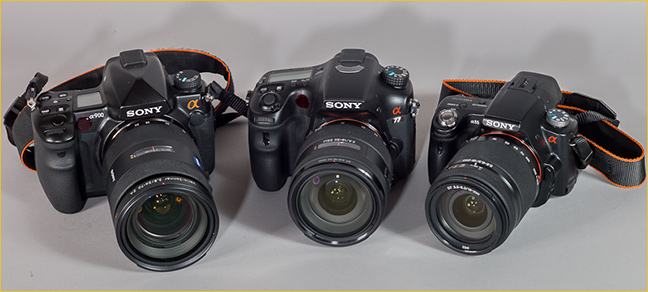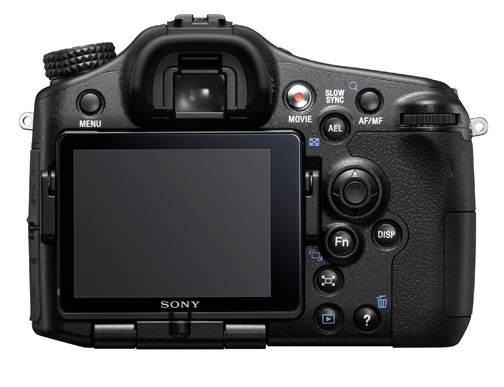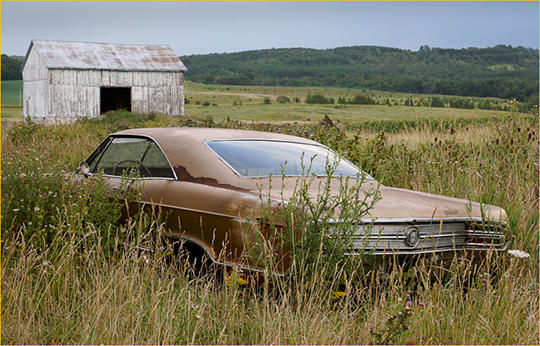
It’s impossible to know what the future will bring. But, it’s likely that theSony A77will be regarded as one of the most fascinating new camera introductions of 2011. The camera was announced on 24 August, and won’t be released until early October. Thanks to Sony Canada I had an opportunity in early August to spend four days field testing a pre-production camera, along with the new 16-50mm f/2.8 lens.
Because the camera’s firmware is pre-production, and there was no user manual or raw software available, it was not possible to put the camera through any rigerous tests, or to do any comparisons. Instead, my time was spent becoming familiar with the camera’s features and functions, and of course shooting as much as I could (though it rained almost every day – Murphey’s Law). This report then is about how the camera handles, how its major features operate, and my initial impressions. There are a couple of images posted, but they are not to be regarded as indicative of what final production cameras are capable of.
As is always the case when reviewing pre-production cameras, the rule of thumb is not to be critical of any aspect of the product that might change prior to release. This is only reasonable. That means that I will not be commenting on feature operation or image quality, both of which are subject to change prior to first shipment.
Hardware issues that can’t be changed, such as the placement of controls, is fair game though.
Recap
At the risk of some repetition, and so that thisFirst Impressions Reportserves as a stand-alone resource, I am repeating in this section most of what was written in my24 August, 2011 Sony Announcementsummary.
The basic specs are that the A77 has a 24.3 Megapixel APS-C sensor. It will be priced at CDN $1,495 body only, and sold together with the also new 16-50mm f/2.8 lens at CDN $2,149. Availability will begin in early October. There will be a full-featured vertical grip available in October as well for $329.
The A77 is weather and dust sealed, as is the new 16-50mm f/2.8 lens. This is the first weather sealed lens from Sony, and the combo should appeal to photographers working in harsh conditions.
The A77 is capable of 12 FPS with continuous autofocus, one of the benefits of its translucent mirror technology. The viewfinder is electronic, using a brand new XGA resolution OLED with 2.3 Million pixels. This viewfinder is a stunner, offering significantly higher resolution, more saturated colours, greater contrast, and higher resolution than any EVF previously available. The viewfinder has eye detection, switching automatically between the EVF and the rear LCD as needed.
Some users have complained about occasionally seeing “ghosting” with the A35 and A33 in some extreme lighting situations due to the translucent mirror. Sony claims to have improved the mirror’s coating onthe A77 and A65 models to help eliminate this issue.
The rear LCD is also a brand new articulated design, allowing positioning forward and above the camera, useful for when shooting stills and video with the photographer on-camera. The LCD’s mechanical mount seems particularly robust.
Other major specifications include 19 point autofocus with 11 Cross type sensors. Available ISO sensitivity ranges from 100 – 16,000 with an optional ISO 50 setting. The shutter mechanism is new, and is claimed to have a 150,000 actuation life, which is in pro-grade territory. The camera’s battery is the same as the one used in the A900/850 (horray) and the vertical grip, which can use two batteries, will drain the weaker one first before switching to the second, allowing the depleted battery to the be changed first. Overall battery life is claimed to be very good as well, though again, eventual field testing will tell the tale.
As mentioned, the camera has a special 12FPS mode, but this locks out manual controls during the burst. When dropping down to 8 FPS (just?!) full manual control of all settable parameters is possible. There is an available electronic first curtain shutter, which is a feature previously seen on some Canon models. What it does is eliminate the need for a physical first shutter curtain. This means that there is absolutely no mechanical motion within the camera until after the exposure, when the second mechanical shutter curtain closes. This along with the fact that the A77 has continuous Live View, and no moving mirror because of its Translucent Mirror technology, means that the A77 will likely be one of the most vibration free cameras ever made. This will make it ideal for macro, microscope, long telephoto and telescope work.
Video has now become a must-have on all cameras, and Sony has pulled out all the stops this time. Nothing is held back. The A77 uses the new AVCHD 2.0 specification, which allows 1080P 50 or 60 FPS at up to 28 Mbps. Serious film makers will also rejoice, because the A77 features 24P, for natural motion picture style cadence. Full manual exposure controls are available when shooting video, but only with manual focus.
There is a built-in GPS, and the camera’s top shutter speed is 1/8,000 sec. There is a built-in flash along with Sony’s proprietary flash hot shoe, and the camera has a PC socket for studio use. As befits a top line camera there is AF fine tuning capability and lens aberration correction.
Wonder of wonders, Sony has brought back the large top LCD panel, highly useful for making settings and instantly being able to view the camera’s status and settings without the rear LCD or EVF. Thanks Sony! This is a major feature for photographers who do more than use their cameras as glorified point-and-shoots, and those who need to controls various settings on a real-time basis.
Speaking of control, the A77’s rear control button have been designed so that each one is at a slightly different height and has a different feel, so that settings by touch are enhanced – great for when working on low light conditions.
Buick and Barn. Creemore, Ontario. August, 2011
Sony A77 with 16-50mm f/2.8 DT SST
In Hand
The A77 is clearly from a new generation of Sony cameras. As I wrote in my 24 August, 2011 Sony Announcement summary , the A77 is a “pretty” camera; one of the nicest styled Sony cameras in a long time. It has a very organic shape and falls to hand very nicely as well.
This camera is clearly aimed at a higher spec category than was the A55. The A77 is significantly larger and heavier, with many more external controls, not to mention a top-panel LCD which summarizes all of the camera’s main settings and is useful while making settings, such as ISO, White Balance, and Exposure Compensation, which are located right next to it on the top panel. The LCD can be illuminated with a button to its right. This all puts it in the same design league as the Prosumer Canon 7D and Nikon D7000.
If the use of the number 7 in the products moniker doesn’t tell you which market segment this camera is aimed at, just consider the numbering used by its direct competition.
In addition to the body’s heft (particularly with the new 16-50mm lens, or one of the Zeiss full-frame lenses), it has a very grip-friendly texture, making handling a pleasure. I found that I was able to hold the camera for extensive periods of time without fearing that it might slip from my grasp, something that all too many cameras with smoother surfaces might.
Anyone coming from an A55 or other smallish Sony camera should be aware that this is a different beast. Like other cameras in this category (Nikon D7000, Canon 7D) notwithstanding what I wrote above about its holdability, this is not a camera that many would walk around with all day, unless the main task of the day was photography. The new A65, with the same sensor and EVF may in fact be a preferable camera for anyone thinking of using one of these for more casual use, travel, hiking, and similar pursuits where low weight and bulk are to be preferred.

Left to Right
A900 with Zeiss 24-70mm f/2.8
A77 with 16-50mm f/2.8 DT
A55 with 18-250mm f/3.5-6.3 DT
User Interface
By my count there are some 23 different buttons and controls on the camera. Most frequently used controls have their own direct access buttons, and their settings can be viewed on the rear LCD, the top LCD, or in the EVF. I was pleased to see that where appropriate there are multiple ways to achieve settings. For example, when the ISO button is pressed the front wheel, the rear wheel, or the joystick can each be used to affect the setting.
Parenthetically, I was very pleased to note that when setting ISO, and choosing AUTO ISO, the rear LCD also displays high and low settings, which the user can change via the joystick. This is a well thought out user interface innovation.
I was also pleased to see that the A77 tells you the ISO that AUTO will be selecting. So many cameras don’t, and simply leave you wondering what the camera is choosing, without an opportunity to intervene until after the shot has been taken.
Customizable Buttons
The AEL, AF/MF and ISO buttons can each be set to one of 28 different functions. This is an admirable level of customizability. There are also three memorizable settings which include just about every possible camera setting, and which can be recalled quickly from a main dial setting. I wish that they each had their own position on the dial, rather than sharing one with a screen selection needed. But, with video, 3D, Sweep Panorama, 12 FPS mode, and Movie mode on the dial, I suppose that there isn’t room.
Function Button
There is a rear panel Function (Fn) button which calls up a left and right of screen menu, on both the rear LCD and EVF. The joystick can then be used to change virtually every shooting parameter.
Menu
The Menu button, to the left of the eyepiece, calls up the usual Sony Alpha style display. It is clear, logically laid out, and straightforward in operation. There are 11 columns in all under seven main headings. Scrolling can be done with either the joystick or the front or rear control wheels. Each column is only one screen long, and there is no need to return to the top of a column to change to the next or previous one, a left or right flick of the joystick does the job.
It is worth noting that the camera’s full menu system is available in the EVF, something that an optical viewfinder based camera can’t offer.
Video
The A77, as with the A65 and NEX-7, utilizes the new AVCHD 2.0 codec recently adopted by both Panasonic and Sony. This allows for 1920 X 1080 HD video at 50P and 60P (location dependant). These cameras can also do 24P / 25P, for those wanting a more traditional film-like cadence. The new standard and this camera also allows for data rates at up to 28 Mbps.
With the A55 we saw for the first time in a DSLR very high speed autofocus while shooting video. The A77 continues this ability.
Video can be shot at any time using the dedicated rear Movie button. This is in a fully automatic mode which allows high speed continious autofocus, but which favours having the lens at maximum aperture (or almost), varying the shutter speed as needed. The camera’s AF requires a constant high aperture.
The camera is also capable of shooting video in Program, Aperture Priority, Shutter Priority and fully manual mode. But, in these modes one is limited to manual focusing. This will not be found to be too great a hardship, because serious video makers prefer manual focusing, and also because the A77 has Sony’s recently introducedPeakingmode, which makes manual focusing a breeze with just about any lens.
My only complaint at the moment is that when set to manual video mode filming can’t be actuated with the normal shutter speed button; only the dedicated Movie button on the rear. Whether it can be activated with the infrared remote release or a wire electronic release remains to be seen, as I had neither available for testing.
Of course because the A77 has a high resolution EVF, the LCD magnifiers that many DSLR film makers use is not required.
Hold the Jello
Though I know that I promised not to discuss image quality in this pre-production review, I have to mention one thing that I noticed while shooting some test video. There is much less visible rolling shutter with this camera than I’ve seen before. If this holds true with a full production camera then DSLR video makers are going to be all over this camera like a kid with a bowl of strawberry jello.
The EVF
The EVF on the A77 is the largest, brightest, highest resolution and most contrasty electronic viewfinder yet, from anyone. Incidentely, it is the same 2.4 MP OLED device as the one on the A65, the NEX-7, and the FDA-EV1 accessory viewfinder for the NEX-5N.
Is it good? Yes, it’s very good – for an EVF. I would go so far as to say that it is much preferable to the dim and small reflex viewfinders found on most reduced frame DSLRs. This then begs the question – how does it compare to the viewfinder on a full frame DSLR like the Sony A900.
Not so well. The viewfinder on the A900 is one of the brightest and largest found on any 35mm DSLR – ever. Sony’s new OLED EVF, as good as it is, is up against what may the gold standard, and it doesn’t quite deliver.
The area where I find EVFs to be problematic is in high contrast situations. As one moves from bright to dark areas the viewfinder’s brightness pumps. I find this distracting. An optical viewfinder allows the eye to compensate for brightness differences, while an EVF (even one as good as Sony’s new one) does its own compensation.
Outdoors the A77’s viewfinder does the job, though shadow areas can become blocked up. In low light I find that it gives an unrealistically bright and contrasty impression of the scene in front of it, and also one that gets grainy as the VF’s amplification is boosted to enhance visibility.
My analysis (and unlike some current US politicians I reserve the right to change my mind based on further experience and evaluation), is that the new Sony EVF is the best yet from any manufacturer, beats most low-end APS-C reflex mirror systems, but still isn’t a patch on a good prism system.
Of course a good EVF allows overlays, such as live histogram and electronic level, not to mention in-viewfinder postview and playback. There are obviously lots of pros and cons to consider and no one right choice.

The LCD
Sony has equipped the A77 with a new style articulated LCD. It is hinged in the center of both sides, and also at its base, to allow swivelling 180 degrees. This allows it to viewable from above, beneath, the left, the right of, in front and behind the camera, while at the same time providing an extremely robust hinge mechanism that looks like it could withstand a huge amount of abuse. There are even notches on its periphery that will allow Sony or some enterprising accessory maker to provide a clip-on sun shade.
Sockets
All camera apertures are apparently sealed against moisture and dust. The battery compartment is on the camera’s base and takes the same FM-500H battery as the A900. A single battery charger ships with the camera.
The card slot is under the right hand grip. It takes both Sony Memorystick style cards (Pro Duo and Pro-HG Duo) as well as SD, SDHC and SDXC cards. There is only one card slot.
All of the other connector slots are on the left side of the camera beneath tightly sealed doors. There is a DC-in socket, a mini-HDMI and USB socket, an external stereo mike socket, and finally a remote control socket with a standard PC flash socket for studio flash applications.
What About Full Frame?
The A77 is a cropped sensor / reduced frame / APS-C sensor camera – whatever you want to call it. This, plus the fact that the A900 is now some three years old, begs the question – will there be an A99? Is a new full frame Sony Alpha on the horizon?
I think that there is, and it even may well use the same (or similar) body as the A77. As mentioned earlier, the A77 is a full-sized camera, with the heft and gravitas that a Prosumer model deserves. It certainly appears as if a full frame sensor could be used with the same chassis (if not the same actual body) as the current one. Nikon’s D700 and Canon’s 5dMKII are of this genre.
If this turns out to be the case then it likely means the end of the reflex mirror / glass prism camera; at least from Sony. My guess (and it’s only a guess at this point) is that Sony will move in this direction. Working pros will likely want to stick with traditional mirrors and prisms, but Sony doesn’t really compete in that segment. The Prosumer market, which is larger and more profitable, will accept Sony’s Translucent Mirror / EVF solution technology for its benefits, and likely forgive it for its deficits.
This raises the question of whether someone interested in a 24 Megapixel Sony camera should consider the now aging A900 or the brand new A77.
I’ll put aside the question of image quality for the moment, since I am not commenting directly on this until I can test a full production A77. But I have no hesitation in saying that the A77’s three year newer sensor is bound to trump that of the A900 at higher ISOs, say above 800. At lower ISOs it may be a push, but based on some very informal first impressions I think that we’ll find that the A77’s sensor is capable of greater dynamic range as well as lower noise. Not at all surprising, even given the higher pixel pitch of the new camera’s smaller sensor. Sony has clearly made some great strides in sensor design during the past few years. (Scaling the A77’s sensor up to full frame would yield what? A 45 Megapixel resolution? Fascinating to contemplate.
So, for the moment – A900 or A77? A tough call. The A900 currently sells for some $2,700; a full $1,200 dollars more than the new A77. The A77 is weatherproof, has higher frame rates, GPS, electronic level, an articulated LCD, and a built in flash. The A900 has one of the world’s best (and maybe last) large and bright reflex prism viewfinders. Like I said – a tough call.
GPS
The GPS works much as those in any other camera. Just as an aside, I noted that the chrome coloured stereo microphone grill on the top of the A77 seems cosmetically out of place. Then it occurred to me that it almost certainly is the GPS antenna. I don’t know this for a fact, but it seems likely, and is a clever solution to a contemporary camera design problem.
I found that the GPS takes about one minute to lock on after 12 hours, being indoors in the same location.
16-50mm f/2.8 DT SST
This new lens will become available in early October (along with the A77) for CDN $799, and bundled with the A77 at a combined price of CDN $2,149. It is not a Zeiss lens (nor priced like it) and is not a G series, so therefore not necessarily top ranked, though thus far Sony has not produced any APS-C lenses in its top G series.
The lens has a fixed f/2.8 aperture, and has a 72mm front thread. It ships complete with a front lens shade. Fit and finish is not quite up to Zeiss standards, but appears to be quite high. There is a lock lever at the 16mm position. Image quality impressions will have to wait till a production lens is available.
What Next
This report is, of course incomplete, because no aspect of the camera’s performance or image quality is discussed. But be assured that as soon as a camera with full production firmware is available, I expect to be able to provide a more comprehensive series of tests. Since the rumours are that first release will be in Japan mid-September, followed by ROW in early October, we won’t have to wait too long to see how the rest of the puzzle pieces fall into place.
24 August, 2011

